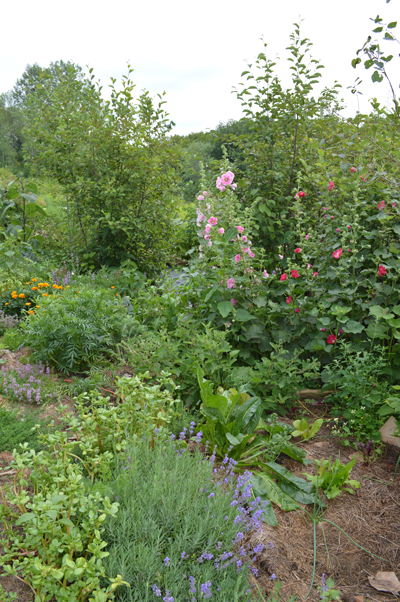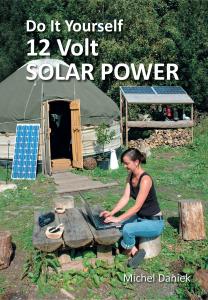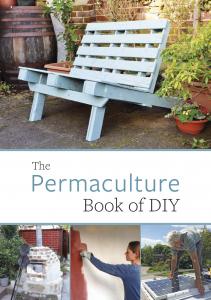 The path to improving the quality of the soil in your garden is both simple, and complicated. Simple in that it may require much less work than you would have thought, and complicated because there are so many ways you can do it, but they all require understanding a few underlying principles of nature.
The path to improving the quality of the soil in your garden is both simple, and complicated. Simple in that it may require much less work than you would have thought, and complicated because there are so many ways you can do it, but they all require understanding a few underlying principles of nature.
It’s about much more than simply spraying the right fertilizer and hoping that it magically gets absorbed by your plants in the amounts they need. Plants have evolved for hundreds of millions of years to work with complex soil ecosystems that help maintain specific soil structures and pH, and dramatically increase the bioavailability and mobility of plant nutrients while also increasing soil water holding capacity, among other things.
All the ways we’ll go over below to create healthy, nutrient-rich soil have three basic objectives: increase bioavailability / absorption of existing nutrients, add any missing nutrients, and increase the efficiency of nutrient cycling (which includes decreasing soil erosion).
-
Mulch and Sheet Mulch
Mulch is not only crucial for weed control, but also for encouraging and protecting the soil and the soil food web of microbes and other allies from the harsh sun, erosive rain, and drying winds, while also providing food for your microbe friends (especially fungi, which will greatly appreciate wood chips, leaves, and other mulch materials).
A boost in microorganisms means more predigested nutrients for plants, along with the binding of those nutrients in the soil both within their bodies, and within the well-structured soil they help to create and maintain.
For a supercharged soil building mulching technique, try sheet mulching, which involves smothering weeds and their seeds with a layer of newspaper or cardboard, followed by alternating layers of nitrogen and carbon rich materials (e.g. compost followed by straw).
-
Plant Diversity
To create more efficient nutrient cycles, plant a diversity of plants with varying root depths and patterns, especially perennials like trees. Perennials have deeper roots that pull nutrients from deeper in the soil profile, while also preventing erosion and nutrient leaching and building soil through their root growth and death cycles. Nitrogen fixing plants are also important to include, since they will help to increase soil nitrogen levels (nitrogen being an important macronutrient).
-
Nitrogen Fixing Bacterial Inoculants
When planting nitrogen fixing plants, it’s important to find the right bacteria inoculant to make sure you get the most out of the plant’s ability to team with these microbes to transform nitrogen from the atmosphere into bioavailable nitrogen in the root systems of the plants.
-
Chop and Drop
One method of quickly building soil is through chop and drop techniques that involve planting specific trees and other plants that will grow back when cut, so you can cut them over and over again to build soil while encouraging and feeding your microbe friends.
-
Green Manures and Cover Crops / Living Mulch / Ground Covers
Cover crops/living mulches/ground covers have the same benefits of regular mulch, but with the added benefit of never having to be reapplied, since they’ll only grow each year, ideally. Meanwhile, green manure, which is simply plants that are planted to then be worked into the soil or cut until they die, will help add nutrients and organic matter to the soil.
-
Compost and Vermacompost
Adding compost, and especially vermacompost (worm castings) is a tried and tested method for adding a healthy dose of nutrients, microbes, and organic matter to the soil, all very important for soil health.
-
Aerated and Non-Aerated Compost Tea
Compost tea is another way of adding fertilizers and microbes to the soil, in highly bioavailable liquid form. Compost tea not only increases nutrient bioavailability, but also helps prevent and treat diseases by filling ecosystem niches with beneficial microbes that will likely discourage pathogens.
-
Effective Microorganisms
Effective Microorganisms are the anaerobic (lacking oxygen) side of the microbe coin, acting in a similar way as compost teas, and they can be ordered online and mixed up at home.
-
Mycorrhizal Inoculants
Mycorrhizal fungi are fungi that have a symbiotic relationship with plants, and inoculating your plants during planting has been shown to increase growth and increase the plant’s chances of survival. Mycorrhizal fungi are especially important for trees and shrubs, acting as a highly effective extension of their root systems.
-
Organic Fertilizers
Some fertilizers, especially concentrated chemical fertilizers like ammonium sulfate or sulfur coated urea can be damaging to soil ecosystems. Instead, go the steady and slow route and use natural fertilizers like composted manures, seaweed, rock dust, volcanic minerals, and natural gypsum, for example, depending on what nutrients are lacking from your soil.
-
Hügelkultur
Hügelkultur is a German technique for building garden beds that involves burying logs and brush in mounds of soil, which dramatically increasing the water holding capacity of the beds while breaking the wood down into rich soil. It is important to add nitrogen rich materials (e.g. compost or compost tea fertilizers) to the mix in order to balance the large amount of carbon in the wood.
-
Swales
Swales are specialized ditches dug on contour, and are used in certain climates and with certain soil types to better infiltrate water into the soil while preventing erosive runoff. Trees and other plants can be planted on and around them, making for increased water to the plants and lessening or eliminating the need for irrigation.
-
Permanent No Till Gardens
No till techniques ensure that the soil structure is maintained, which in turn helps to maintain the soil’s water holding and nutrient holding capacity, preventing nutrient leaching and erosion. Tilling also causes disturbance that leads to weed seeds germinating, actually causing more weeds in the long run by exposing the soil’s seed bank.
-
Avoid Soil Compaction
Another important consideration is avoiding compaction, which destroys the soil structure and damages the soil food web by limiting water and oxygen penetration, while also making it harder for plant roots to grow and thrive. This is why avoiding heavy machinery is important, especially when the soil is moist (moist soil is easier to compact), and why it’s important to create permanent beds with paths and stepping stones that allow you to access the beds without walking on them.
-
Subsoil Plow and Broad Fork
Besides avoiding compaction, you can also reverse and repair existing soil compaction caused by people or machines. On a large scale, one can use a subsoil plow to plow lines on contour (renting a laser level is a good idea for marking contour lines) every 20 feet or so, starting at the highest elevation of the landscape and working down. This will create channels for water and oxygen infiltration, which will in turn boost soil health. On a smaller scale, one can use a broad fork (basically a large garden fork that cuts through the soil) in the garden to break up compaction layers while avoiding the mixing of soil layers (which can damage the soil food web). If all else fails, a regular garden fork can be used, but avoid mixing soil layers.
As you can see from the above tips, the most important way to improve the soil in your garden is to think of your soil as the ecosystem it is and to focus on maximizing the health of that ecosystem, just as nature does on its own in forests, grasslands, marshes and other ecosystems. Instead of simply trying to force feed your soil artificial nutrients, create a healthy soil food web that will break down and make nutrients available to plants as they need them, without disrupting your plants’ ability to get what they need on their own, thus creating much less work for you, and a healthier environment for your plants.
The most important way to improve the soil in your garden is to think of your soil as the ecosystem it is and to focus on maximizing the health of that ecosystem, just as nature does on its own in forests, grasslands, marshes and other ecosystems. Instead of simply trying to force feed your soil artificial nutrients, create a healthy soil food web that will break down and make nutrients available to plants as they need them, without disrupting your plants’ ability to get what they need on their own, thus creating much less work for you, and a healthier environment for your plants.



